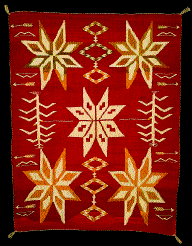A Personal Look at Navajo Weavings
|
Art patrons are generally not privy to the artist or the artist's inside/out process. This process is private, personal,
and often sacred. When in the role of consumers, we are initially beckoned by the outside/in view that is usually based on personal taste;
and then slowly begins the magical process of internalization.I have tried to become part of both aspects of the art experience, endeavoring
to learn both facets, inside/out and outside/in. |

Navajo Rug
woven at Crystal, New Mexico
c1900–1915
|
The subject at hand is Navajo weavings: the rugs, blankets, and tapestries woven by creative Navajo women and the occasional
Navajo male weaver. As cultural outsiders (non-Navajos) we learn about "the" Navajo art form from books, deductive reasoning and observation.
These methods keep us from getting very close to the essence, but, as "outsiders", this is as close as we can get.
Navajo weavings are statements defining the artist's relationship to her natural surroundings and her personal standards
relative to geometry, color, proportion and spiritual relation to the Earth. One cannot view early Navajo weavings without recognizing
the suggestion of regional rock formations and deep space. These visual observations or perceptions, combined with natural dyed wool whose
color source is derived from plant, animal or mineral pigments, results in a tapestry of relationship and relatedness revealing an appropriate
holistic cultural statement in "art" form.
|
|
When viewing or considering contemporary weavings, this wholeness remains as part of the experience but the purer original
cultural insight, awareness and presence is less prevalent or profound and affords less emotional impact because of the nature of contemporary
designing, thinking and materials. Generally, objects should be judged relative to their date of origin and the circumstances surrounding
and affecting the artist. We cannot fairly compare a weaving dating 1890 to one produced in 1990. This truth can be clearly described by
the descriptive and insightful terms "pre-electric and post-electric" Navajos. As soon as electricity became available on the Navajo reservation,
subsequent to the railroad, life radically changed and so did the art forms. Radio, television, telephone and magazines brought non-cultural
related values, issues and sense of place. Consider whether cola-drinking, bluejean-wearing, automobile-driving, contemporary-thinking
Navajo women could ever continue the original primary essential cultural inside/out process.
It matters little what you pay for your Navajo weaving as long as your purchase is of the best quality in whatever price
range your comfort level allows. Be open for a little room to stretch your budget and spend a little more today confidently knowing that
by extending your budget you will acquire the best possible enduring work of art that will please you for years to come.
The Fox in Saint-Exupery's The Little Prince says,
"It is only with the heart that one sees rightly,
what is essential
is invisible to the eye."
This insight, I assure you, is in the being of the weaver. My friend Alan says, "Accept [an artist's] work
on an intuitive level." Maybe if you like the object, you'll really like the person who made it. |
Thoughts from Andrew Nagen. He appraised, bought and sold old Navajo rugs and blankets in Corrales, New Mexico from 1976 until his death in August 2005.
Originally appeared in
The Collector’s Guide to Santa Fe, Taos and Albuquerque - Volume 15
|
|

